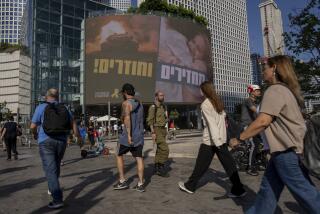Gaza tunnel network threat leaves Israelis shaken
Reporting from Kibbutz Erez, Israel — Beneath the wheat and watermelon fields surrounding this farm community just outside the Gaza Strip lies a threat that helps explain the overwhelming public support in Israel for the war against the Palestinian militant group Hamas.
A little over a week ago, assailants dressed in Israeli military uniforms clambered out of an underground passageway about halfway between this hamlet of 400 or so people and a neighboring kibbutz, Nir Am. Israeli troops killed nine of them, but not before the attackers killed four soldiers.
The specter of such assaults via a large and sophisticated network of subterranean passageways has profoundly shaken Israelis long accustomed to a different threat from the coastal strip, that of rocket and mortar fire. Four such infiltrations have taken place since the start of the Gaza offensive, killing at least 11 Israeli soldiers and haunting the collective psyche.
“From this, you can’t protect yourself,” said Ruti Sheves, 64, who has lived in Kibbutz Erez for 40 years. “You don’t have a shelter where you can run and be safe. You can’t be safe from this.”
Troops operating in and near Gaza have tracked 36 tunnels with dozens of access points, Deputy Foreign Minister Tzachi Hanegbi said Wednesday, as the Israeli offensive in Gaza entered its fourth week. Miles of passageways, many stocked with weapons and reinforced against explosions from above, pass near or directly beneath schools, mosques and hospitals, threading their way under some of the most densely populated terrain on Earth.
“We already finished destroying more than 22, and it’s going on day and night,” Hanegbi said. “We want to go as fast as possible.”
Hamas for years has boasted that tunnels are an equalizer in an asymmetric battle. This week, Israelis were horrified by video Hamas released of an attack outside Nahal Oz, another farming community just outside the Gaza boundary, that left five Israeli soldiers dead.
Grainy but gripping, the attacker’s-eye images begin underground, emerging to open fields and blue sky. Lasting nearly four minutes, the video shows the assailants — faces blurred to prevent identification — exchanging fire with Israeli soldiers. They stand over one body and fire repeatedly at close range. One attacker triumphantly displays a seized machine gun.
The army has countered with its own brand of tunnel video, releasing almost daily images of specially trained troops gingerly dismantling booby traps and uncovering dark passageways.
The presence of the tunnel network has long been known to Israel; one was used to stage the 2006 attack that resulted in the kidnapping of Israeli soldier Gilad Shalit. He was held captive in Gaza for five years before being freed in a massive prisoner exchange.
But the underground grid’s scope, scale and sophistication, which has become clear over the course of the current offensive, has caught many by surprise. Concrete-lined, with electricity and metal tracks for transport, the carefully ventilated passageways appear to have been designed as the conduit for both large-scale assaults and clandestine abductions. Israel says it has found “kidnap kits” consisting of handcuffs and tranquilizers in some of the tunnels.
In the heated rhetoric surrounding the fighting in Gaza, which has killed more than 1,200 Palestinians, many of them women and children, the tunnels have emerged as the key Israeli rationale for keeping up the fight rather than agreeing to a cease-fire lasting for longer than a matter of hours. The tunnels are also cited as the principal reason for military operations taking place in the heart of jam-packed Palestinian residential neighborhoods, which have exacted a heavy civilian toll.
“We will not complete the mission, we will not complete the operation, without neutralizing the tunnels, the sole purpose of which is the destruction of our civilians and the killing of our children,” Israeli Prime Minister Benjamin Netanyahu said this week.
Fueling the anxiety among Israelis, the Maariv newspaper cited intelligence sources as saying that Palestinian militants had planned to use the tunnels to infiltrate Israel with a force consisting of hundreds of fighters disguised as Israeli soldiers, in an assault timed to the Jewish New Year, Rosh Hashana, in late September.
Under heavy international pressure as the bloodletting mounts in Gaza, Israel appears to be trying to buy time to continue destroying the tunnel network.
“We are only a few days away from destroying the attack tunnels,” said Maj. Gen. Sami Turjeman, the head of Israel’s southern command, said in a televised briefing Wednesday night. He sounded a note often echoed by Israeli officialdom: Hamas could have built “two hospitals, 20 schools, 20 clinics and 100 kindergartens” with the cement and other materials used to construct the tunnels.
Attention to the tunnel network has supplanted even the alarm over the more than 2,500 rockets and missiles fired at Israel during the offensive. Debate about whether the discovery of the scope of the problem represents an intelligence failure has been muted by reluctance to criticize the army at what is seen as a time of crisis.
How best to deal with the threat in the long term has been dissected and discussed by a parade of technical experts. Destroying the tunnels is almost as much of an engineering challenge as constructing them must have been, military officials say.
Though technology plays a role in uncovering the passageways, Reserve Brig. Gen. Shimon Daniel, a former head of the army’s combat engineering corps, said intelligence and surveillance collected over a long period played an equally important role.
Like other officers who have been immersed in tunnel tracking, he cited the unnerving psychological dimension of the tunnels in the eyes of the Israeli public.
“Most threats you hear and see,” he said. “But this has the element of surprise, of the unknown, and that’s very frightening to people.”
At Kibbutz Erez, residents set up a 24-hour “war room” in one of the community’s bomb shelters. It was here that they gathered to monitor events during the July 21 alert while soldiers were battling the tunnel-borne assailants.
The drama took hours to play out. After Israeli spotters detected the assailants’ presence, there was hasty and frantic debate about whether they might actually be Israeli forces. So convincing were the attackers’ counterfeit uniforms that they even had regulation-style bands to keep pant legs from bunching when tucked into boots.
It was only after drone surveillance revealed that the men who mysteriously appeared in the fields at dawn were carrying Kalashnikov assault rifles, which are not used by the Israeli military, that troops moved definitively against them, Israeli news reports said later.
Kibbutzniks expressed sympathy for the suffering of Palestinian civilians in Gaza. But like Israelis as a whole, according to a series of public surveys, most felt there was no choice but to uproot the tunnels by whatever means necessary. Many had curtailed routines like walking alone on pathways skirting farm fields, green expanses that were once a soothing sight.
“This is our home, and we’re not leaving,” said Orna Naim, 52, who together with her husband had raised three children at Kibbutz Erez. “We wish we could live as neighbors, in peace. But this has to stop.”
Twitter: @laurakingLAT
Special correspondent Batsheva Sobelman in Jerusalem contributed to this report.
More to Read
Sign up for Essential California
The most important California stories and recommendations in your inbox every morning.
You may occasionally receive promotional content from the Los Angeles Times.








